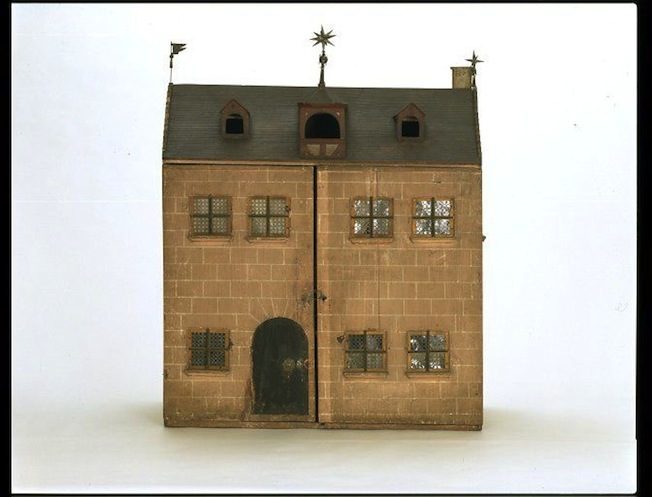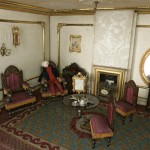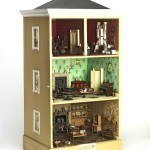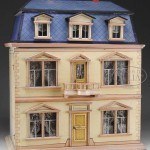Nuremberg House
The Nuremberg House was made in 1673 and is the oldest dollhouse on display at the Victoria & Albert Museum in London. It is small, measuring approximately 42” high, 36” wide and 18” deep, much smaller than most “puppenhausen” made in Nuremberg during that period.
The Original Owners
We know something about the original owners just by looking at the doll’s house. The year it was made is written on the chimney. A sign or picture on the exterior of a house would show the proprietor’s occupation. In this case, there is a unicorn with a broken horn above a window next to the entrance that shows the house belonged to a chemist or an apothecary.
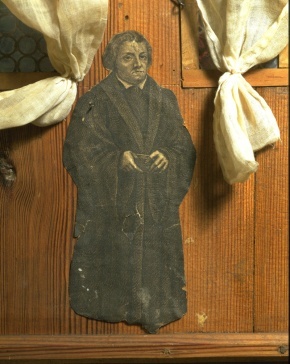
Picture of Martin Luther on the right-hand door of the Nuremberg House.
Churchgoers
They were a religious family, Lutherans probably, judging by the picture of Martin Luther (1483-1546) on the right door. A miniature hymnal and a prayer book are in a bedroom.
Also, note the stars on the house, popular ornamentation in 1673. They were eventually banned because they tended to fly off in times of high wind, becoming dangerous missiles.
Displays of Wealth
A 17th-century German dollhouse usually served two purposes. In most of Europe, creating an elaborate dollhouse was a popular way for the upper classes to flaunt their wealth. They could be architecturally accurate miniatures of their manor houses. Or as in the case of the Dutch cabinet baby houses, clear depictions of daily life.
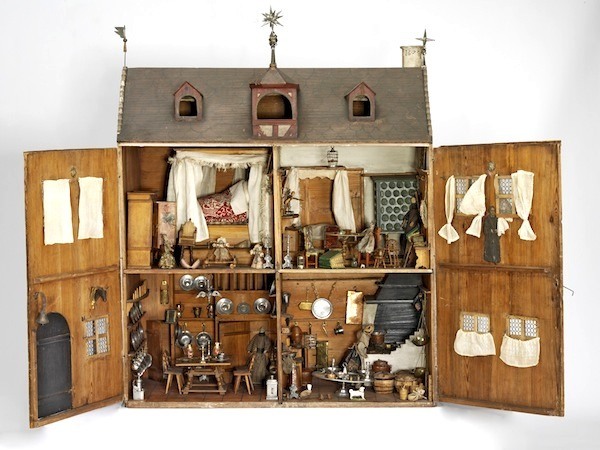
Interior of The Nuremberg House on display at the Victoria & Albert Museum
A Training Tool
The practical Germans added a second function, teaching the children skills they would need to run a household, and teaching the staff how to do the chores. The Nuremberg house is a good example. With only four rooms – two kitchens and two bedrooms – it was not designed to show family life. Rather, the house would be an enjoyable way for children and staff to learn the practical aspects of household management, from the preservation of food to the acquisition and storing of linen.
The Best Kitchen
Guests would be greeted at the arched door, which opened into the “best” kitchen. Particular attention would have been paid to the appearance of this room, ensuring that it was welcoming … and ostentatious. Candlesticks and silver dishes would be brought to a high polish. The table would be set with all the food and drink required for a lively evening with the family and their guests.
A practical note: the privy can be seen in the back, lefthand corner.
Working Kitchen
This was a labor-intensive place where all the messy part of food preparation and preservation was done. Scrub, clean, cook, prepare sausages, hang hams in the chimney to smoke, all the time being careful not to step on the chickens running free, unaware of their coming fate. Another task that was done in the working kitchen, unrelated to food preparation, was the annual washing of the linen. It was a monumental job, requiring day labor hired locally to help with the work.
Bedrooms
The master bedroom of the house contains a four-poster bed with feather mattresses and a doll in a detailed high chair. The main bedroom appears to serve as both a bedroom and a sitting room. The large stove is painted green, with the flu to the outside. This is representative of stoves of the period.
Susan Downing, with Patrick Owens
_________________________________________________________________________
I invite you to visit my Etsy Shop where I offer many accessories and pieces of furniture in 1:12 scale.


